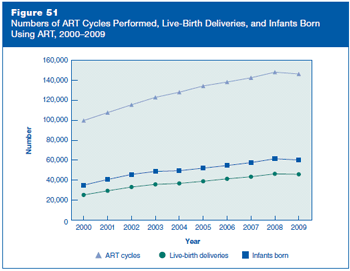What Infertility Can Teach Us about Customizing Healthcare Protocols
I know what you're thinking: How can an issue like infertility teach us about customizing healthcare? And how can the assisted reproduction field help raise standards in women's healthcare? But it can, and it does… or it should.
I know what you're thinking: How can an issue like infertility teach us about customizing healthcare? And how can the assisted reproduction field help raise standards in women's healthcare? But it can, and it does… or it should. As a high-profile, still controversial medical specialty that serves millions of women, fertility and reproductive specialists must be at the forefront of responsible, personalized treatment… and they must pave the way for ob/gyn as a whole.

Figure courtesy of the Centers for Disease Control and Prevention, Division of Reproductive Health, National Center for Chronic Disease Prevention and Health Promotion
Infertility, which affects 7.3 million women and their partners in the United States alone, can be a devastating issue that couples face on the road to parenthood. More and more women are using assisted reproductive technology (ART)-the number of ART cycles performed in the United States rose nearly 50% from 2000 to 2009-but it’s still a controversial arena. Some politicians and religious leaders blindly urge for more regulation or total abandonment of this area of medicine, and many recall the most infamous stories, like that of the Octomom, who fell victim to her doctors' (and her own) negligence. Such stories, however, need not become the symbol for an entire field of medicine, and it is unfortunate that this is often the case. But in order to maintain the highest standards of fertility care, reproductive endocrinologists (REs) must conduct their fertility practices with a judicious combination of scientific knowledge and interpersonal understanding of the patient at hand.
The fertility care sector's leading authorities continue to promote the customization of IVF care plans that meet the physiological, financial, and ethical needs of infertility patients. One of the best recent examples of the changing face of in vitro fertilization (IVF) came at the annual meeting of the American Society for Reproductive Medicine (ASRM), which, along with the Society for Assisted Reproductive Technologies (SART), called on the fertility community to expand its practice of single embryo transfers (eSET), which greatly reduces the chance of multiple pregnancies. Multiple pregnancies contribute to a variety of perinatal issues, and can lead to high and unexpected healthcare costs if the children end up in NICU-all things which minimally invasive IVF protocols aim to prevent.
Fertility centers are taking note, and forward-thinking physicians are diligent about customizing fertility care. Dr. John Zhang of New Hope Fertility Center encourages his doctors to cater to the unique needs of each patient, ensuring that there is no “cookie cutter” approach and each woman is treated on an individual basis. This often means applying elements of specific New Hope protocols based on the patient's history (e.g., miscarriage, non-responder to IVF elsewhere, irregular ovulation) and using these as building blocks to create a "one-of-a-kind" IVF protocol.
On example of how customization best serves the patient is the case of Krissy Green*, who arrived at New Hope at the age of 39 suffering from primary infertility due to oligoovulation (irregular ovulation). Although never able to get pregnant on her own, her RE, Dr. Lyndon Chang, used the clinic's minimal stimulation protocol, Mini-IVF™ (no injectable drugs compared to conventional IVF protocols), to help Green conceive. The fact that she was able to produce several embryos through her Mini-IVF™ treatment "was a huge indicator that her ovaries would have been hyperstimulated under conventional IVF," Chang said. "The only reason she was not able to get pregnant was because of the inability to ovulate properly, which is why we took a more minimally invasive approach."
Another patient, Angela Johnson, was successfully treated with Natural Cycle IVF, which requires no fertility drugs whatsoever, after failing under conventional programs elsewhere.
Policies that encourage physicians to thoroughly understand each individual case put the patient's health and safety at the forefront of her fertility care plan, and also greatly decrease the costs associated with conventional IVF treatments, which involve high levels of medication at high prices. Through close monitoring, Zhang and his team have been able to help their patients conceive with less medication, and therefore at lower costs and with fewer side effects.
New Hope also makes certain to understand and accommodate religious and ethical needs (e.g., number of embryos created from treatment) of patients who have those concerns during their fertility care treatment.
High costs, overmedication, and negligence are all factors that must be considered when pursuing specialized healthcare, and especially in the field of women’s health, which is so often in the media spotlight. By taking into account the unique health background and personal history of its patients, fertility centers can lead the way towards establishing more patient-centered and cost-effective protocols. Sometimes, in the case of IVF and ART, this means steering the patient to other alternatives like surrogacy or adoption in order to preserve her health.
"It should be about using the science to best serve the patient," Zhang said, "not just the transaction."
*all names have been changed
S1E4: Dr. Kristina Adams-Waldorf: Pandemics, pathogens and perseverance
July 16th 2020This episode of Pap Talk by Contemporary OB/GYN features an interview with Dr. Kristina Adams-Waldorf, Professor in the Department of Obstetrics and Gynecology and Adjunct Professor in Global Health at the University of Washington (UW) School of Medicine in Seattle.
Listen
